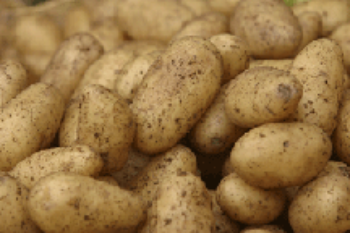Potatoes

The trusty potato is one of the earliest vegetables to be planted in the garden. Potatoes are an easy and abundant crop to grow in the garden, but there are some tricks to success in growing this crop. Let’s learn a bit more about the potato.
What variety do I plant?
Potato cultivars will vary in appearance, maturity, growing requirements, and culinary quality, but all of them are excellent sources of nutrients. Potatoes are extremely versatile as they can be baked, boiled, chipped, fried, roasted, and used in various soups, salads, and stews. It is important to choose a variety that will suit your culinary needs. Some varieties are mealy in texture and work best when turned into potato chips or fries, whereas others will be sweeter in flavor and suitable for boiling, roasting, or salads. Potatoes are divided into three categories: Red-Skinned, White-Skinned, and Russet potatoes. Red-skinned varieties contrast with meat and other vegetables. They tend to have a lower starch content, which makes them suitable for boiling, roasting, and use in soups and stews. White-skinned varieties have a wide range of starch content, so knowing your variety before you plant them is essential. Lower starch content varieties work well in boiling and roasting, whereas higher starch varieties are suitable for chips or frying. Yukon Gold is a very versatile potato variety and the most popular in the US. Russet potatoes are known for their brown netted skin. Many of these cultivars are suited for making French Fries and other frozen processed products. See the table on the second page for more information on varieties.
You’ve picked your variety, now what do you do?
The first thing you need to do is look for certified seed potatoes. Certified Seed potatoes are disease-free, crucial in preventing diseases from getting into your soil. Potatoes from the grocery store have typically been sprayed with a chemical to prevent them from sprouting, and they could develop diseases even though they look fine to eat.
How many potatoes do you need, and what do I do with them?
For a 100-foot row of potatoes, you will need about 10 pounds of potatoes to plant. After you have your seed potatoes, it’s time to cut them into pieces. You will typically get multiple pieces from each potato. When cutting the tubers, the pieces should be about the size of a golf ball, and each should contain an “eye” or a location where the potatoes will sprout. Eyes are typically indentions in the tuber. Use a sharp knife to cut your potato into pieces. I usually let my potatoes “heal” for several days to develop a skin before planting them. I find it helps to prevent rotting in the soil.
When and how do I plant Potatoes?
Tradition has said to plant potatoes on St Patrick’s Day. However, it is best to check the temperature of the soil either using a soil probe or by looking at the closest weather station to you. Potatoes need soil temperatures at or above 45 degrees (which we were above last week, but I still wouldn’t be planting potatoes yet) to sprout and grow, so watch those temperatures. Potatoes should be planted in rows 30-36 inches apart with 10-inch spaces between the potato pieces themselves. I highly recommend “hilling” your potatoes or building up the soil around the plants to give the tubers space to grow and prevent the skins from greening.
When do I get to enjoy the “fruits” of my labor?
Potatoes can be harvested anytime during the growing season as new potatoes typically are smaller, or wait till the end of the growing season to harvest when the potato plants die—store potatoes in a cool, dark place for the most extended shelf life. Please don’t wash them before storing them, which encourages disease and spoilage. At room temperature, potatoes will retain their best quality for about a week, but they can last far longer at cooler temperatures.

Have questions? Contact our office where our Horticulture Extension Agent will assist you with questions.
Phone: (316) 321-9660
Email: callae@ksu.edu